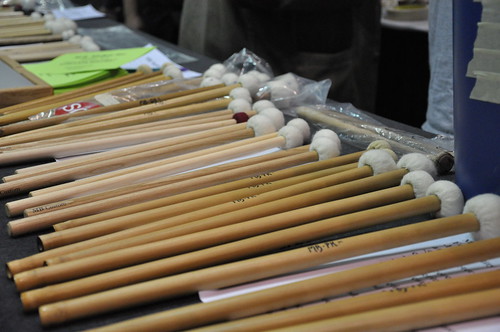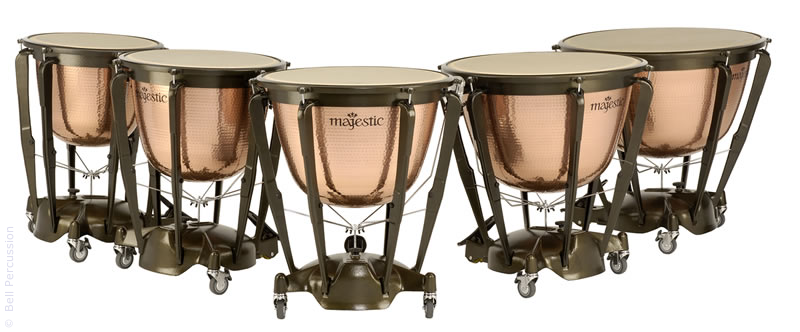One thing we all learn with experience is that life goes in phases. Not too long ago, but neither too recently, I had a “sketchy timpanist nearly ruining the concert” phase with a number of different orchestras over several concerts. Some regular players were missing, and I, and the audiences, had a bit of a rough ride- the low point of which was probably the chap who skipped a repeat in a classical symphony and stayed off from the orchestra for the remaining 11 minutes of the movement in spite of all the best efforts of the trumpet section, bass section and even the conductor. After the concert, he was heralded as the “Helen Keller of the timps” by his colleagues.
This was a bit of a shock, because for much of my career, I’ve been lucky to work with some very, very fine timpanists. I’ve also watched some young players and amateurs develop from a limited skill set and emerge as really fine timpanists and artists. I hope our work together helped them on their way.
A great timpanist is a conductor’s secret weapon- they’re right up there with the concertmaster for being able to shape the sound of the whole orchestra for better or worse. They can galvanize the rhythm of the entire band, or cause a train wreck of Biblical proportions. A great timpanist brings the whole orchestra to life. A not so great one has the opposite effect.
So what makes a great timpanist? Is it the ability to count 37 over 25? Is it a minivan full of drums, and a box of 800 sticks? Is it a practiced expertise at eye rolling, or starting blankly ahead when being spoken to? No, no and no.
I think I can de-mystify the art of the timpanist in four pictures.
How to become a great timpanist
You can spend a lot less on these

Photo- Eric Pancer
And even these
And invest it instead in more of these
And especially these
A timpanist should be 3% percussionist, and 97% musician extraordinaire.
A timpanist needs to have achieved a certain minimum threshold of technical skill.
You probably also need two pairs of sticks (one hard, one soft). You can hold off buying the other 600 sets of sticks until you can tune your drums properly and can get through any standard repertoire piece without a counting error or an ensemble problem. Maybe you can even wait to buy those other sticks until you’ve cultivated every possible sound and articulation you can achieve with minimal variety of kit?
A great timpanist combines this skill with a razor sharp ear for pitch, an encyclopedic knowledge of the repertoire, a string quartet player’s ensemble skills, an understanding of how all the instruments in the orchestra produce sound and and a sense of rhythm that embraces nuance, rubato, stylization and direction. A great timpanist not only knows what their playing sounds like where they are, but how it sounds in the hall, and most importantly, how it affects the sound of everyone else on stage. You learn this last skill through listening- listening to recordings, watching your colleagues and teachers rehearse and listening to recordings of your own performances every chance you get.
Counting flawlessly is also much appreciated.
Pages on this website contain copyrighted material reproduced without profit for educational purposes under Fair Use provisions of relevant copyright laws. Copyrighted material remains the property of the owners and will be removed on request



Your comments about tympanists are very apt. As a principal player in a major Canadian orchestra, I have seen the good that a great tympanist can do to galvanize an ensemble. They need to play with as much character as any principal soloist should be able to do. All you have to do is listen to the Royal Concertgebouw Orchestra. They have one of my all time favourite players!!!
A sampling of Facebook response:
“Hear, hear!” Eric S- timpanist
“Great blog.” Eric C- timpanist
“So the secret to being a great timpanist is being a responsible musician? Who knew?! I found this article rather pretentious and condescending.”
Matthew- timpanist
More to come! What do you think?
I’m a little late to the party here… I agree with the sentiment of your article and believe it’s great advice for students who try to use sticks/equipment to compensate for technical deficiencies. (Personally, I couldn’t afford to buy sticks en masse, but have accumulated many over the years, purchased when the situation called for it.) Although not about timpani, I’d like to point you to a great article on the subject by Craig Knox, principal tubist of the Pittsburgh Symphony. http://www.craigknoxtuba.com/a-few-thoughts-on-equipment.php
A good example of “a great timpanist brings the orchestra to life” would be David Herbert’s recent appointment to the Chicago Symphony- his effect is similar to that of a turbo or a super charger on an already high performance engine!